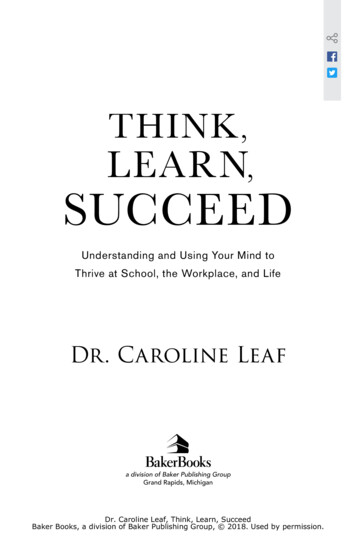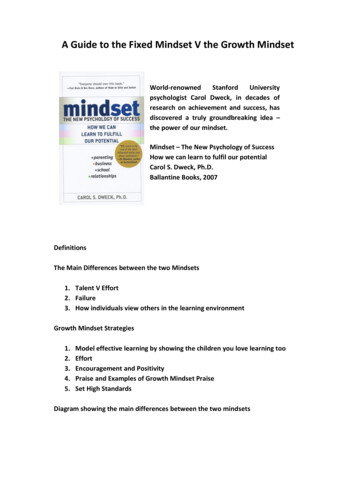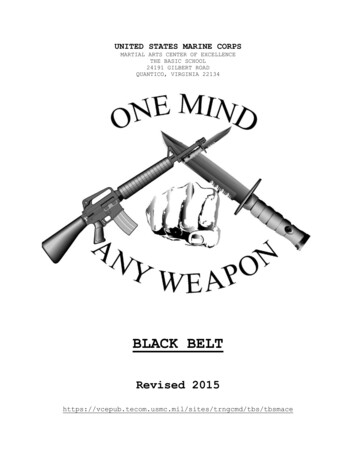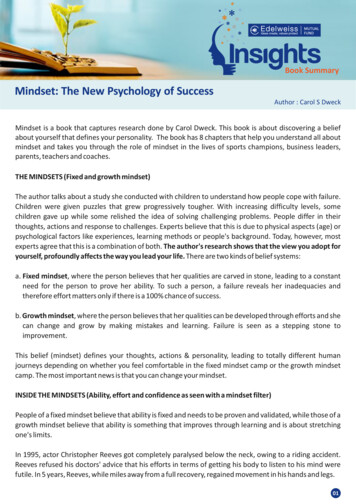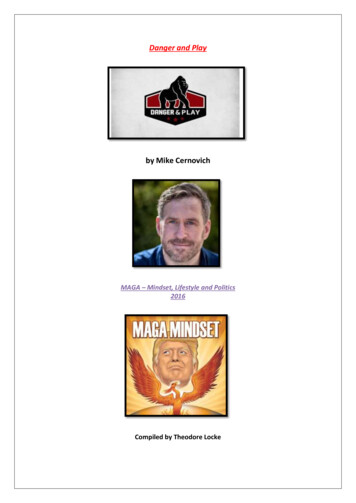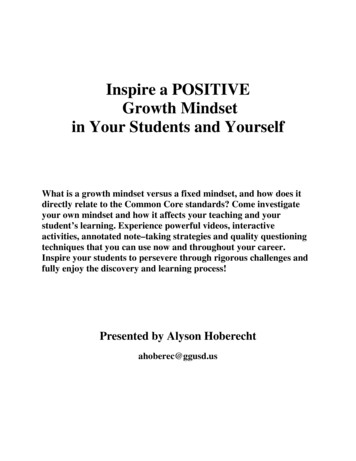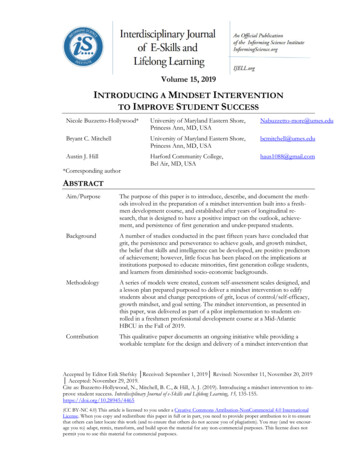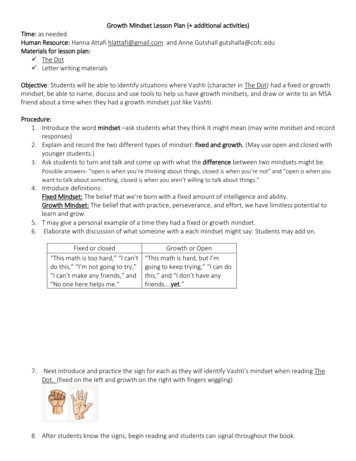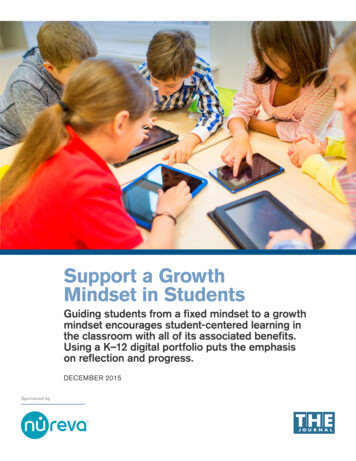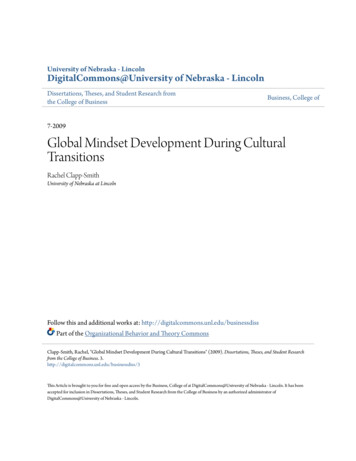
Transcription
University of Nebraska - LincolnDigitalCommons@University of Nebraska - LincolnDissertations, Theses, and Student Research fromthe College of BusinessBusiness, College of7-2009Global Mindset Development During CulturalTransitionsRachel Clapp-SmithUniversity of Nebraska at LincolnFollow this and additional works at: http://digitalcommons.unl.edu/businessdissPart of the Organizational Behavior and Theory CommonsClapp-Smith, Rachel, "Global Mindset Development During Cultural Transitions" (2009). Dissertations, Theses, and Student Researchfrom the College of Business. 3.http://digitalcommons.unl.edu/businessdiss/3This Article is brought to you for free and open access by the Business, College of at DigitalCommons@University of Nebraska - Lincoln. It has beenaccepted for inclusion in Dissertations, Theses, and Student Research from the College of Business by an authorized administrator ofDigitalCommons@University of Nebraska - Lincoln.
GLOBAL MINDSET DEVELOPMENT DURING CULTURAL TRANSITIONSByRachel Clapp-SmithA DISSERTATIONPresented to the Faculty ofThe Graduate College at the University of NebraskaIn Partial Fulfillment of RequirementsFor the Degree of Doctor of PhilosophyMajor: BusinessUnder the Supervision of Professor Fred LuthansLincoln, NebraskaJuly 2009
GLOBAL MINDSET DEVELOPMENT DURING CULTURAL TRANSITIONSRachel Clapp SmithUniversity of Nebraska, 2009Advisor: Professor Fred LuthansThis dissertation sought to explore two research questions: what is the process of globalmindset development and how can it be accelerated? The components that werehypothesized to contribute to global mindset development were cultural self-awareness,cognitive complexity, cultural intelligence, positivity, and suspending judgment.Culturally appropriate behavior served as the outcome of the process. Overall, it wasfound that a path model with the three main variables of cultural self-awareness,cognitive complexity and cultural intelligence had a strong fit. However, an interactionwith positivity and partial mediation of suspending judgment were not supported. Theresults testing how to accelerate the process were inconclusive, as changes over theduration of the study were not present, likely due to a brief testing period of 10 days.Overall, however, the study is one of the first empirical explorations of global mindsetdevelopment and its contributions to a budding area of research are discussed, as well asimplications for management and future directions.
iiiDEDICATIONThis dissertation is dedicated to Tyler, Harrison and Molly for their constant support andunderstanding and for helping me keep a sense of humor.AUTHORS ACKNOWLEDGMENTSThe author would like to acknowledge the intellectual support of Drs Bruce Avolio, MaryUhl-Bien and Fred Luthans. Thank you for continually challenging my assumptions andhelping me to see new perspectives.
ivTABLE OF CONTENTSCHAPTER ONE: INTRODUCTION TO THE STUDY 1Purpose of the Study . . .1Global Leadership . . .4Origins of Global Mindset . .9Level of Analysis . .10Theoretical Model . .11Research Questions 17Organization of the Dissertation . 17CHAPTER 2: LITERATURE REVIEW .19Culture 20Meaning Making 22The Working Self-Concept 25Acculturation .28Biculturalism .30Overview of the Model of Global Mindset Development .31Culturally Induced Trigger Moments 32Cultural Self-Awareness 35Cognitive Dissonance 36Cultural Cognitive Complexity .37Cognitive Cultural Intelligence .40Moderation and Mediation in the Global Mindset Model .44Positivity 45Suspending Judgment 48Outcomes of Global Mindset Development .51Intensity of Culturally Induced Trigger Moments 55Summary, Integration and Conclusion .56CHAPTER 3: METHODS .58Context of Study 58
vDevelopment of Intervention .60Pilot Study .60Sample 61Procedure . 61Sample for Main Study .62Procedure. 64Measures. 64Cognitive Complexity 65Suspending Judgment 67Cultural Intelligence. .67Positivity 68Culturally Appropriate Behavior .68Covariates . 69Manipulation Check .69Conclusion .70CHAPTER 4: RESULTS .72Regression Analyses for Hypotheses 1-5 .74Results of Structural Equation Modeling of Time Data 78Findings Testing Time 1 versus Time 2 82Discussion .83Limitations . .91Practical Implications 94REFERENCES .98APPENDIX A: MEASURES .105APPENDIX B: TRIGGER SCENARIOS .113APPEMDIX C: RESULTS .121
viLIST OF FIGURESFigure 1Theoretical Model of the Process of Global Mindset DevelopmentFigure 2Conceptual Pillars of Global MindsetFigure 3Moderation Effect of Positivity on the Relationship between Cultural Selfawareness and Cognitive ComplexityFigure 4Hypothesized Main Effects ModelFigure 5Hypothesized Main Effects Model Adjusted According to Mod. IndicesLIST OF TABLESTable 1Sample MeansTable 2Frequency of Second Language AbilityTable 3Reliabilities of MeasuresTable 4Correlations of Study Variables from Entire Time 1 SampleTable 5Correlations of Study Variables from Time 1 Reduced SampleTable 6Correlations of Study Variables from Time 2 SampleTable 7Hypothesis 1: Perspective-Taking Regressed on Cultural Self-AwarenessTable 8Hypothesis 2: Cognitive Cultural Intelligence Regressed on PerspectivetakingTable 9Hypothesis 3: Moderation Effect of PositivityTable 10Hypothesis 4: Partial Mediation Effect of Suspending Judgment: Openmindedness as ProxyTable 12Hypothesis 5: Behavioral Cultural Intelligence Regressed on CognitiveCultural intelligenceTable 13Time 1 Results of CFA and Main Effects Structural ModelTable 14Descriptive Statistics and Paired Samples T-testsTable 15Hypothesis 6: Repeated Measures ANOVATable 16Post-Hoc Analysis for Culturally Appropriate Behavior as DVTable 17Comparison of Samples across Study Variables
1GLOBAL MINDSET DEVELOPMENT DURING CULTURAL TRANSITIONSCHAPTER ONEINTRODUCTION TO THE STUDY“Culture eats strategy for breakfast.” – Jerry Rawls, CEO, FinisarPurpose of the StudyIn a panel discussion regarding authentic leadership, Jerry Rawls uttered these wordsto highlight the impact that culture has on even the best strategic plans, which organizationsoftentimes fail to implement at rates hovering about 70% (Charan & Colvin, 1999).Contributing to such strategic implementation failures is the impact of global trends onbusiness strategy that have challenged the leadership of small, medium and largeorganizations. These leaders need to address the growing challenges of operating in a globalmarketplace where information, services and goods rapidly cross borders in ways that haveenhanced the competitive landscape for most organizations.We now live in an era in which interactions with culturally diverse suppliers,customers, regulators, and employees take place regularly, either face to face or virtually.Not only have the transformations associated with globalization made organizational leadersmore likely to come into contact with people from a diverse range of other cultures, butinformation technology has enabled all leaders and followers to have more frequent virtualinteractions with parts of the world that many individuals probably didn’t know existed(Thomas & Inkson, 2004).
2As this increased interaction across every imaginable geographic and culturalboundary occurs, the need to make meaning of it and to find ways to incorporate theglobalizing world with our own understanding of the community in which we live hasbecome increasingly apparent to both management scholars and practitioners (Kegan, 1994;Markus & Kitayama, 2003; Thomas & Inkson, 2004; Triandis, 1980). To begin addressingthis call, the current dissertation will focus on developing the concept of “global mindset”and identifying how individuals may acquire a global mindset.The concept of global mindset has been suggested by scholars as a way to achieve abetter understanding of ways to engage in appropriate levels of cross-cultural functioning,(Bartlett & Ghoshal, 1998; Gupta & Govindarajan, 2004). Global mindset has been definedas “the cognitive ability that helps individuals figure out how to best understand andinfluence individuals, groups, and organizations from diverse socio/cultural systems”(Beechler & Javidan, 2007; Clapp-Smith, Luthans, & Avolio, 2007: 110). In today’s businessenvironment companies are increasingly looking for ways to develop global mindset amongtheir leaders. To be successful in the global economy, leaders must have the ability tonavigate the needs and norms of multiple cultural groups simultaneously. Global mindsetprovides leaders with the capacity to not only understand the nuances of culture, but to alsohave a broader understanding of the impact of global trends on local strategies.Despite the critical need for understanding global mindset, to date little empiricalresearch has been conducted to build a model of global mindset. Therefore, this study aims totest a process model of what constitutes a global mindset. To understand how global mindsetprovides leaders the capacity to understand and influence individuals, groups andorganizations from diverse cultural systems, I propose that it is comprised of cultural
3awareness, cognitive complexity, cultural intelligence, positivity, and the capacity to suspendjudgment.In addition to laying a broader conceptual and empirical foundation to the emergingtheoretical work on global mindset, this study will examine the process through which a“global mindset” develops in individuals. Many scholars addressing the actualization of aglobal mindset have commented on development in broad-brush strokes, often suggestingthat companies send employees abroad as a means to acquire a global mindset (Beechler &Javidan, 2007; Gupta & Govindarajan, 2004). However, very few have recommended aprocess model that explains how the ability to function successfully across a diverse range ofcultures, as global mindset is defined above, can be enhanced and accelerated. Therefore, thisstudy also aims to understand the developmental process that produces global mindset.A final gap in the extant global mindset literature deals with the understanding ofglobal leadership. This is a challenging issue that results from prior cross-disciplinaryattempts at defining global leadership. Specifically, the need for global mindset and how it isconstrued is often linked to leadership through the justification that leaders’ greatestchallenges today typically stem from a rapidly globalizing world (Beechler & Javidan, 2007;Black, Morrison, & Gregersen, 1999; Gupta & Govindarajan, 2002; Ireland & Hitt, 1999).Such discussions have emerged in the strategy literature with the outcome of thesediscussions presenting two specific dilemmas. The first is that leadership has been equatedwith a management position or role, e.g., CEO, thus ignoring how many leadership scholarsdefine leadership at any level of an organization as a process, not a person or role. Thesecond dilemma stems from the levels of analysis. Scholars who study strategic managementand leadership operationalize and analyze key constructs such as strategic management at the
4firm level. For example, Perlmutter and Bartlett and Ghoshal blur the lines between theindividual level (CEO) and the firm level, defining them as almost synonymous. To tacklethis issue, the secondary goal for this study is to more clearly define what constitutes globalmindset at the individual level of analysis and to establish a theoretical link to leadership thattakes into account the social influence process characterizing leadership as opposed to thecurrent view from the strategy literature of the individual manager who finds herselfmanaging a culturally diverse group of employees.Taking these points into consideration, in this study global mindset will be definedand operationalized as a general perspective taking capacity, characterized by cultural selfawareness, cognitive complexity, positivity, cognitive cultural intelligence, and the ability tosuspend judgment that enables individuals to integrate multiple cultural paradigms in order tounderstand and influence culturally diverse social events and interactions.This chapter is organized as follows. I first set the stage with an overview of theliterature of what constitutes global leadership and why global mindset is interconnected and,at times, practically synonymous with this concept. I then discuss the issue of levels ofanalysis and justify why I am pursuing in this dissertation operationalizing and testing globalmindset at the individual level. Then, and most importantly, I discuss the available empiricalevidence that supports the theory of global mindset development. I also describe how myproposed theoretical model depicts the developmental process associated with the emergenceof a global mindset. I conclude this first chapter by outlining the research questions that arederived from the theoretical model.Global Leadership
5Who would believe that simply adding the descriptor global to the concept ofleadership would make for a definitional nightmare? Applying leadership to a global contexthas been examined thus far in several different streams of management literature asrepresenting the management of individuals from diverse socio-cultural backgrounds(Beechler & Javidan, 2007), the strategic management of multinational corporations (Bartlett& Ghoshal, 1998; Doz & Prahalad, 1987), and similarities and differences in how leadershipis construed and displayed across different cultures (Bass, 1997; Gerstner & Day, 1994;House, Hanges, Javidan, Dorfman, & Gupta, 2004; Peterson & Hunt, 1997; Scandura &Dorfman, 2004). However, how global leadership is defined tends to depend on the researchagenda of the scholar(s) defining the concept within each of the respective streams. Forexample, in reviewing global leadership literature, Hollenbeck found different approachesand understandings of global leadership depending on the academic perspective ororientation. He noted that six academic perspectives address global leadership: strategic,cross-cultural, expatriate, competency, adult learning, and leadership perspectives(Hollenbeck, 2001). Hollenbeck’s review highlights what is problematic about definingglobal leadership: each perspective defines global leadership based on the organizational roleof interest. Hence, expatriates and their managers are defined as global leadership from theexpatriate perspective, while executives of multinationals represent global leadership fromthe strategic perspective.With previous global leadership definitions removed from leadership theory andlimited to an organizational role, I will take as a starting point for defining global leadershipwhere most leadership scholars begin in terms of the most cited definition of leadership fromYukl and Van Fleet. “Leadership is viewed as a process that includes influencing the task
6objectives and strategies of a group or organization, influencing people in the organization toimplement the strategies and achieve the objectives, influencing group maintenance andidentification, and influencing the culture of the organization” (Yukl & Van Fleet, 1992:149). The essence of the definition implies that leadership is a process in which influenceoccurs. This influence can occur at any level, such as at the follower level as well as at anyleadership position level within an organization. Further descriptions of leadership includethe importance of followers and context in depicting this social influence process (Avolio,2007). As such, leadership viewed from the perspective of an individual manager or role, ashas been typically done in the strategy literature, is quite limiting.This isn’t to say that individuals who have global responsibilities do not in some waycontribute to the leadership process. They certainly do, and referencing work from Marionand Uhl-Bien’s (2001) complexity theory of leadership, I argue that they serve as tags orcatalysts in an influence process. But what is this influence process that we want to callglobal?Yukl and Van Fleet note that the influence process can occur around strategies,people, tasks, group identity, and organizational climate. As such, leadership often createsthe conditions that enable desired outcomes to occur. The primary difference when we talkabout global is that the context of the influence process changes. Instead of influencing astrategy for a single market, strategy formulation needs to balance global efficiencies of thefirm with local demands. The tasks that leadership may influence may require different pathsto achieving them given different political, economic, and social structures. The peopleinvolved with the shift in context come from diverse cultural backgrounds and thus may notshare cultural norms and values. Group identity of a multi-cultural group must balance
7multiple socio-cultural perspectives. An organizational climate, when being impacted byglobal cultural influence processes, must balance the norms and values of the organizationwith a diverse range of cultural norms and values. Therefore, when we discuss globalleadership, the influence process associated with this leadership must begin to take intoconsideration the contextual factors of diverse societal cultures including norms and values,as well as different economic and political systems. The overarching definition that will beused to guide the work in this dissertation is that global leadership represents a social processthat transcends cultural boundaries, influencing strategies, people, tasks, groups, andorganizational culture by accommodating diverse cultural norms and values within theframework of the institutions and structures that are created by and reinforce said culturalnorms and values.Many scholars have conducted studies or proposed theories to help us betterunderstand how an influence process may vary across cultural boundaries. The GLOBEproject, for instance, has underscored what constitutes people’s implicit notion of what is andis not associated with the leadership process. The GLOBE authors have found that there arecertain commonalities across cultures such as leaders influence others by the vision, values,and roles they articulate for followers (House et al., 2004). Armed with such information, onemay believe that it is easy to influence global processes if one simply enacts such behaviorsdeemed to be effective or perhaps ‘universal’ across many diverse cultures.As another example, we might assume that building trust is a universally endorsedcharacteristic associated with leaders (House et al., 2004). Consequently, a leaderparticularly adept at building trust in one culture might be expected to build similar levels oftrust in another culture, expecting a similar positive impact. GLOBE provides a broad range
8of cross-cultural data that helps us to understand what different cultures value and whichbehaviors influence people and organizational processes to achieve desired goals. We knowfrom the GLOBE results that people universally value integrity and trust, yet we still seemany leaders continue to fumble building trust in other cultures as the actual behaviors andactions that build such trust may vary from one culture to another.The key distinction that needs to be made is between what we know about globalcultural differences and then how we go about using that information for positive gain.Specifically, global mindset takes the “what” or data representing a particular culture (norms,values, and vague behaviors) and then helps the individual translate that data into the “how”(how does one best establish trust with this group of people? How is a vision bestcommunicated to another group of people?). As such, global mindset is highly implicatedwith the notion of global leadership, as without it, the knowledge once gained about differentcultures may still not be used in a way that achieves either the leader’s or organization’sgoals. This then leads to the assumption that individuals who are part of the leadershipprocess (leaders and followers) must navigate the contextual (and cultural) factors thatcontribute to or impede the influence process, and will do so more or less effectivelydepending on what I have defined herein as global mindset.From a practical perspective, the next generation of leaders and followers mustdevelop meaning making strategies that allow them to transcend cultural boundaries wheredifferences may exist. Such strategies will enable leaders and followers to recognize thenuanced nature of entering new and different cultures, to integrate the information andknowledge into a personal system of meaning, and to use that meaning to guide thedevelopment of behavioral repertoires that are consistent with both their self-concept and
9with the cultural context of interaction. This leads us to the second question of interest in thisdissertation, namely the development of this capacity (global mindset) that enables a positiveinfluence process in the global context (global leadership).In sum, given the implications of global mindset in achieving global leadership, it isimportant to explore the theoretical and practical origins of global mindset and the levels ofanalysis that apply to the construct. Following such a discussion, I then outline how mytheoretical model, when tested, will validate the construct as well as provide insight into thedevelopment of global mindset.Origins of Global MindsetAlthough the term global mindset has appeared relatively recently in a number ofresearch streams, the concept has been present for several decades. Many scholars attributePerlmutter’s characterization of a geocentric attitude, or a state of mind that has a worldorientation, rather than a home-country orientation (Perlmutter, 1969), as the formal origin ofa global mindset in the literature (Gupta & Govindarajan, 2002; Levy, Beechler, Taylor, &Boyacigiller, 2007). In his conceptualization of a geocentric attitude, Perlmutter argues thatexecutives with a global mindset seek the best employees, regardless of their nationality.Such executives would view a subsidiary as a supplier of hard currency, new skills, andknowledge of advanced technology that can transcend cultural boundaries. Perlmutter alsoargues that subsidiary managers in these cultural contexts must look beyond their nationalborders for serving local customers as well as for finding demand for their products.Bartlett and Ghoshal (1998) termed a similar concept a transnational mindset.Executives with a transnational outlook are able to balance the local demands ofmultinational subsidiaries, while retaining a perspective of global efficiency for the overall
10company. In other words, when considering the dichotomous demands of a multinational(global strategy versus a local strategy (Doz & Prahalad, 1987)), Bartlett and Ghoshal arguethat neither alone are ideal and that executives of multinationals need to develop aperspective to address the demands on both a local and global imperative that relate to havinga transnational mindset. This argument implies an individual level meaning-making processthat integrates the paradoxical situation of being both global and local from a strategicperspective. Thus, as strategy researchers, Bartlett and Ghoshal set out with a firm levelperspective, but determine an individual level construct was necessary to center in on whatconstituted a transnational mindset. They, as well as Perlmutter and many other strategists,have blurred the lines in terms of the levels of analysis that apply to both operationallydefining and measuring a global mindset. As such, a discussion of the levels of analysis thatapply to global mindset is necessary to clarify the direction of the theory put forth in thisstudy as well as my operational definition of this construct.Level of AnalysisKlein, Tosi, and Canella (1999) comment that one barrier to multilevel theorydevelopment is often the tradition of our training. For instance, the origins of global mindsetcome from the strategy field, which focuses, in general, on a more macro level of analysis.However, many scholars have made the argument that for global mindset to exist at the firmlevel, executives within a firm must possess a global mindset. Such recommendations have,indeed, blurred the levels of analysis rather than developed a coherent multilevel theory.By implying a multilevel relationship between executives of a firm and firmcharacteristics in the global context, global mindset has been described as an individual levelconstruct in which cognitive processes occur that allow a multinational to have firm level
11characteristics and firm level outcomes. While such a multilevel approach to global mindsettheory is valuable at some future point in time, before such a construct can be either deemedisomorphic or to influence macro-level outcomes, it must be defined and validated at onelevel in order to further theorize at multiple levels (Klein, Tosi, & Cannella, 1999). As such,and drawing from the definition of global mindset to entail cognitive processes, this studyaims to validate an individual level construct so that future research may systematicallytheorize and test cross-level effects (Rousseau, 1985), and then establish whether globalmindset can be defined and exist at the macro-level, as suggested by Perlmutter and Bartlett& Ghoshal. I turn now to describing my theoretical model that serves as a justification forexploring the concept of global mindset at the individual level of analysis. The modeldescribes how trigger moments, cultural self-awareness, cognitive complexity, culturalintelligence, positivity, and suspending judgment relate to each other in developing globalmindsets.Theoretical ModelThe theoretical model that I propose begins with culturally induced trigger moments.These trigger moments are an antecedent to cultural self-awareness as they initiate theexpansion of cultural self-awareness, which in turn increases cognitive complexity. Theawareness of one’s culture and that of others may require additional cognitive categories toaccommodate this new awareness and thus individuals are expected to develop richerdimensionality in their categorization of cues and stimuli. The relationship between culturalself-awareness and cognitive complexity is moderated by positivity, since a positive state ofmind allows individuals to be more receptive to new stimuli/information and to take aninquisitive stance towards them (Fredrickson & Branigan, 2005). Cognitive complexity, then,
12is expected to have a positive relationship with cultural intelligence, as the ability tounderstand complex relationships allows individuals to build strategies for attaining andapplying cultural knowledge. Suspending judgment partially mediates this relationship, as themore individuals take a systems view of events (cognitive complexity) the more theyunderstand the limitation of quick judgments based on minimal or superficial information.Suspending judgment, in turn, increases cultural intelligence by accessing more informationfor developing cultural knowledge. Finally, cultural intelligence leads to culturallyappropriate behavior, as individuals have the motivation to apply cultural knowledge toadjusting their behavior. Figure 1 depicts my proposed model and below, I expand on each ofthese relationships, supplying the theoretical justification for each component and theirlinkages within the proposed model.----Insert Figure 1 about here-----Global mindset development can be viewed as a process of reframing a cognitivereference point, shifting a worldview, or developing a new paradigm of meaning orperspective taking (Bartunek, 1988; Westenholz, 1993). A culturally induced triggermoment often presents paradoxical information that is so strangely new that individualscannot rely on existing frames or schema to understand the situation. Scholars who haveresearched the development of global executives have noted that the one developmentalmoment that global executives share in common is culture shock that leads to a perspectivechanging experience (Hollenbeck & McCall, 2001:53). While this is broadly described based
13on interview results, there is evidence that what is occurring is that the moments are oftenexposing the limitation of current cultural frames of reference that guide how theseindividuals derive meaning from experience, make decisions (Clapp-Smith & Hughes, 2007),and ultimately initiate greater cultural awareness.Cultural awareness refers to one’s understanding of how an individual’s culture oforigin influences one’s thinking. Markus and Kitayama have noted that “cultural contextsand social situations provide the very frames within which psychological systems develop”(Markus & Kitayama, 2003:281). Other authors have argued that cultures provideconventions for “sampling information and determine how much to weigh the sampledelements from the environment” (Triandis & Suh, 2002). Once aw
cultures, as global mindset is defined above, can be enhanced and accelerated. Therefore, this study also aims to understand the developmental process that produces global mindset. A final gap in the extant global mindset literature deals with the understanding of global leadership.
